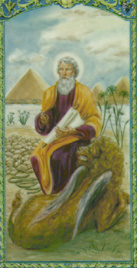We ask you, humbly: don't scroll away.
Hi readers, it seems you use Catholic Online a lot; that's great! It's a little awkward to ask, but we need your help. If you have already donated, we sincerely thank you. We're not salespeople, but we depend on donations averaging $14.76 and fewer than 1% of readers give. If you donate just $5.00, the price of your coffee, Catholic Online School could keep thriving. Thank you.Help Now >
Wilgefortis
FREE Catholic Classes
A fabulous female saint known also as UNCUMBER, KUMMERNIS, KOMINA, COMERA, CUMERANA, HULFE, ONTCOMMENE, ONTCOMMER, DIGNEFORTIS, EUTROPIA, REGINFLEDIS, LIVRADE, LIBERATA, etc.
The legend makes her a Christian daughter of a pagan King of Portugal. In order to keep her vow of chastity, she prayed God to disfigure her body, that she might evade the command of her father to marry a pagan prince. God caused a beard to grow on her chin, whereupon her father had her crucified. Connected with this legend is the story of a destitute fiddler to whom, when he played before her image (or before her crucified body), she gave one of her golden boots. Being condemned to death for the theft of the boot, he was granted his request to play before her a second time, and, in presence of all, she kicked off her other boot, thus establishing his innocence.
The legend is not a Christian adaptation of the Hermaphroditus of Greek mythology or of other androgynous myths of pagan antiquity, as it cannot be traced back further than the fifteenth century. It rather originated from a misinterpretation of the famous "Volto Santo" of Lucca, a representation of the crucified Saviour, clothed in a long tunic, His eyes wide open, His long hair falling over His shoulders, and His head covered with a crown. This crucifix, popularly believed to be the work of Nicodemus, is preserved in the Basilica of Lucca and highly venerated by the people. In the early Middle Ages it was common to represent Christ on the cross clothed in a long tunic, and wearing a royal crown; but since the eleventh century this practice has been discontinued. Thus it happened that copies of the "Volto Santo" of Lucca, spread by pilgrims and merchants in various parts of Europe, were no longer recognized as representations of the crucified Saviour, but came to be looked upon as pictures of a woman who had suffered martyrdom.
 Hi readers, it seems you use Catholic Online a lot; that's great! It's a little awkward to ask, but we need your help. If you have already donated, we sincerely thank you. We're not salespeople, but we depend on donations averaging $14.76 and fewer than 1% of readers give. If you donate just $5.00, the price of your coffee, Catholic Online School could keep thriving. Thank you. Help Now >
Hi readers, it seems you use Catholic Online a lot; that's great! It's a little awkward to ask, but we need your help. If you have already donated, we sincerely thank you. We're not salespeople, but we depend on donations averaging $14.76 and fewer than 1% of readers give. If you donate just $5.00, the price of your coffee, Catholic Online School could keep thriving. Thank you. Help Now >
The name Wilgefortis is usually derived from Virgo fortis , but recently Schnürer has shown that Wilgefortis is probably a corruption of Hilge Vartz ( Vartz, Fratz , face), "Holy Face". This would corroborate the opinion that the legend originated in the "Volto Santo". The old English name Uncumber , as also the German Oncommer and their equivalents in other languages, rose from the popular belief that every one who invokes the saint in the hour of death will die ohne Kummer , without anxiety. When the cult of St. Wilgefortis began to spread in the fifteenth and sixteenth centuries, her name found its way into various breviaries and martyrologies. Thus a breviary, printed at Paris for the Diocese of Salisbury in 1533, has a beautiful metric antiphon and prayer in her honour. Her feast is celebrated on 20 July. She is usually represented nailed to a cross: as a girl of ten or twelve years, frequently with a beard, or as throwing her golden boot to a musician playing before her, sometimes also with one foot bare.








 Daily Readings for Thursday, April 25, 2024
Daily Readings for Thursday, April 25, 2024 St. Mark: Saint of the Day for Thursday, April 25, 2024
St. Mark: Saint of the Day for Thursday, April 25, 2024 Prayer for Policemen: Prayer of the Day for Thursday, April 25, 2024
Prayer for Policemen: Prayer of the Day for Thursday, April 25, 2024


